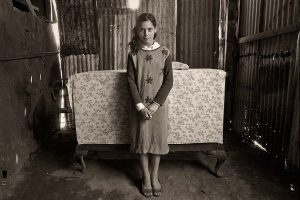In some ways, societies generate a kind of unique identity thanks to their culture and other anthropological elements. I think this gives photographers from each country a common sensibility that makes their images somehow related and easy to identify. Photographers can have extremely varied and diverse styles, but my hypothesis is that they reflect more or less the same “cultural identity”, almost in the same way that people in general can respond their whole life to the same passion. Some days ago, I put special emphasis on Mexican photographers, and this time I want to focus on Argentinian photographers. I hope you like them.
Daniel Mordzinski (1960 – )
Personally, I feel a deep fascination with the work of Daniel Mordzinski. His work is a solid example for all those who have felt the existential worry of pursuing not just a style, but a specific style within a photographic niche. Daniel specializes in only one type of people – writers – and he portrays them like no one else. He has portrayed Hispanic American authors for more than three decades.
One of the masters of “Environmental Portrait” is without a doubt Arnold Newman, but he worked with different types of people, from theater critics to fluorescent lighting professionals, from Woody Allen to Francisco Franco. That is why Mordzinski’s titanic effort is far more impressive to me, because his level of specialization is so high that he really sets the bar for every photographer out there.

Most of his images capture the essence of writers as we imagine them, allowing us to enter into the intimacy of their creative spaces and ideas. To some extent, Daniel is an ambassador for literature lovers who enables us to approach our literary heroes and idols.
I wanted to discuss Daniel's work first because I find it fascinating how he portrayed many of my literary heroes, people like Roberto Bolaño and Jorge Luis Borges. In the middle of May this year, the Museum of Art in my country had the fortune of receiving a sample of more than 200 photographs taken by Daniel, all of them depicting Hispanic authors. I was mesmerized while wandering in the midst of so many of my heroes, along with a vast number of other writers who were unknown to me.
That's the magic I felt when I saw these pictures, and it’s been something I wanted to share with you ever since. You can see a lot of Daniel’s images here.
Rodrigo Abd is an Associated Press photographer who was part of a team that won the prestigious Pulitzer Prize in 2013 for their coverage of the Syrian Civil War. His began as a staff photographer at La Razón and La Nación newspapers in Buenos Aires, Argentina, from 1999 to 2003. In 2003, he became a staff photographer for the Associated Press in Guatemala, with the exception of 2006, when he was based in Kabul, Afghanistan. He has always been recognized for the passionate way in which he portrays subjects that are too scabrous and harsh for many photographers. Honestly, his images are strong, but they have a rather intriguing aesthetic, despite being related to moments as raw as death itself.

A curious fact about Rodrigo is that he has shot several images with a 19th-century wooden camera he acquired in Afghanistan. I mention this because it shows us not only his skill, but also that the camera isn’t what makes the images – it’s the photographer.
You can see more of his work here. Viewer discretion is strongly advised.
Andy Goldstein is an expert in creativity and teaching. Without a doubt, his best-known work is “Vivir en la Tierra” a series of 66 large-format photographs in which he portrays families in informal settlements in 14 Latin American countries, which happen to be very common in the continent.
I had the opportunity to take a class with Andy, and through him I learned about how important it is to know the intention of a photograph before even beginning to work on it in post-production. By only adjusting the white balance, Andy was able to make all the audience feel different feelings and perceptions about a scene. He made us feel afraid, and then protected, with the same image, just by adjusting the image's temperature.

Apart from this great experience, I also saw his sample of “Vivir en la Tierra“, in which the grand size of the images transports the spectator to precarious and common locations throughout Latin America.
You can see more of his work here.
Romina Ressia is the youngest of the photographers I present today, and she is an important figure in the art photography scene. Her work is characterized by portraits with an obvious Renaissance influence, very similar to the way in which Hendrik Kerstens has based his portraits on Flemish paintings. The curious thing is that Romina (like Hendrik) has juxtaposed modern and vernacular elements in her images, giving them a unique character and modern context.

In her early career she was dedicated to fashion photography, and gradually she turned her eye to the fine-art world. Her works are represented by galleries in the United Kingdom, New York, Switzerland and Italy and have been exhibited in major cities including New York, Milan, United Kingdom, Zurich, Paris and Buenos Aires.
We can appreciate her excellent work here.
Easter Egg
Internet and Geography has given me the fortune of connecting with amazing people with time, now I want to share with you a video made by a fellow Argentinian photographer who has been working hard to create a solid magazine that features only the best of contemporary Latin American documentary photography. Before the Claps, by Jorge Piccini.








1 Comment
Surely ALEJANDRO CHASKIELBERG deserves a showing here https://chaskielberg.com/